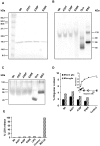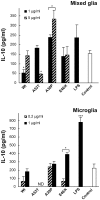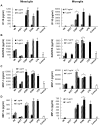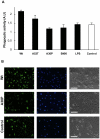Glial innate immunity generated by non-aggregated alpha-synuclein in mouse: differences between wild-type and Parkinson's disease-linked mutants
- PMID: 21048992
- PMCID: PMC2964342
- DOI: 10.1371/journal.pone.0013481
Glial innate immunity generated by non-aggregated alpha-synuclein in mouse: differences between wild-type and Parkinson's disease-linked mutants
Abstract
Background: Parkinson's disease (PD) is a progressive neurodegenerative disorder characterized pathologically by the presence in the brain of intracellular protein inclusions highly enriched in aggregated alpha-synuclein (α-Syn). Although it has been established that progression of the disease is accompanied by sustained activation of microglia, the underlying molecules and factors involved in these immune-triggered mechanisms remain largely unexplored. Lately, accumulating evidence has shown the presence of extracellular α-Syn both in its aggregated and monomeric forms in cerebrospinal fluid and blood plasma. However, the effect of extracellular α-Syn on cellular activation and immune mediators, as well as the impact of familial PD-linked α-Syn mutants on this stimulation, are still largely unknown.
Methods and findings: In this work, we have compared the activation profiles of non-aggregated, extracellular wild-type and PD-linked mutant α-Syn variants on primary glial and microglial cell cultures. After stimulation of cells with α-Syn, we measured the release of Th1- and Th2- type cytokines as well as IP-10/CXCL10, RANTES/CCL5, MCP-1/CCL2 and MIP-1α/CCL3 chemokines. Contrary to what had been observed using cell lines or for the case of aggregated α-Syn, we found strong differences in the immune response generated by wild-type α-Syn and the familial PD mutants (A30P, E46K and A53T).
Conclusions: These findings might contribute to explain the differences in the onset and progression of this highly debilitating disease, which could be of value in the development of rational approaches towards effective control of immune responses that are associated with PD.
Conflict of interest statement
Figures






Similar articles
-
FcγRIIB mediates the inhibitory effect of aggregated α-synuclein on microglial phagocytosis.Neurobiol Dis. 2015 Nov;83:90-9. doi: 10.1016/j.nbd.2015.08.025. Epub 2015 Sep 3. Neurobiol Dis. 2015. PMID: 26342897
-
Microglial phagocytosis is enhanced by monomeric alpha-synuclein, not aggregated alpha-synuclein: implications for Parkinson's disease.Glia. 2008 Aug 15;56(11):1215-23. doi: 10.1002/glia.20691. Glia. 2008. PMID: 18449945
-
Human alpha-synuclein-harboring familial Parkinson's disease-linked Ala-53 --> Thr mutation causes neurodegenerative disease with alpha-synuclein aggregation in transgenic mice.Proc Natl Acad Sci U S A. 2002 Jun 25;99(13):8968-73. doi: 10.1073/pnas.132197599. Proc Natl Acad Sci U S A. 2002. PMID: 12084935 Free PMC article.
-
Role of α-synuclein in inducing innate and adaptive immunity in Parkinson disease.J Parkinsons Dis. 2015;5(1):1-19. doi: 10.3233/JPD-140491. J Parkinsons Dis. 2015. PMID: 25588354 Free PMC article. Review.
-
Immunological features of alpha-synuclein in Parkinson's disease.J Cell Mol Med. 2008 Oct;12(5B):1820-9. doi: 10.1111/j.1582-4934.2008.00450.x. Epub 2008 Jul 30. J Cell Mol Med. 2008. PMID: 18671754 Free PMC article. Review.
Cited by
-
Neuroglial Senescence, α-Synucleinopathy, and the Therapeutic Potential of Senolytics in Parkinson's Disease.Front Neurosci. 2022 Apr 19;16:824191. doi: 10.3389/fnins.2022.824191. eCollection 2022. Front Neurosci. 2022. PMID: 35516803 Free PMC article. Review.
-
Microglial Phagocytosis and Its Regulation: A Therapeutic Target in Parkinson's Disease?Front Mol Neurosci. 2018 Apr 27;11:144. doi: 10.3389/fnmol.2018.00144. eCollection 2018. Front Mol Neurosci. 2018. PMID: 29755317 Free PMC article. Review.
-
The Peripheral Inflammatory Response to Alpha-Synuclein and Endotoxin in Parkinson's Disease.Front Neurol. 2018 Nov 20;9:946. doi: 10.3389/fneur.2018.00946. eCollection 2018. Front Neurol. 2018. PMID: 30524354 Free PMC article.
-
Eicosanoid receptor subtype-mediated opposing regulation of TLR-stimulated expression of astrocyte glial-derived neurotrophic factor.FASEB J. 2012 Jul;26(7):3075-83. doi: 10.1096/fj.11-200279. Epub 2012 Apr 12. FASEB J. 2012. PMID: 22499581 Free PMC article.
-
Glia and alpha-synuclein in neurodegeneration: A complex interaction.Neurobiol Dis. 2016 Jan;85:262-274. doi: 10.1016/j.nbd.2015.03.003. Epub 2015 Mar 10. Neurobiol Dis. 2016. PMID: 25766679 Free PMC article. Review.
References
-
- Eriksen JL, Wszolek Z, Petrucelli L. Molecular pathogenesis of Parkinson disease. Arch Neurol. 2005;62:353–357. - PubMed
-
- Moore DJ, West AB, Dawson VL, Dawson TM. Molecular pathophysiology of Parkinson's disease. Annu Rev Neurosci. 2005;28:57–87. - PubMed
-
- Chiti F, Dobson CM. Protein misfolding, functional amyloid, and human disease. Annu Rev Biochem. 2006;75:333–366. - PubMed
Publication types
MeSH terms
Substances
Grants and funding
LinkOut - more resources
Full Text Sources
Other Literature Sources
Medical
Miscellaneous

